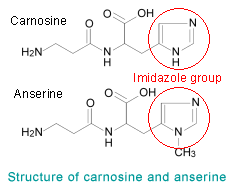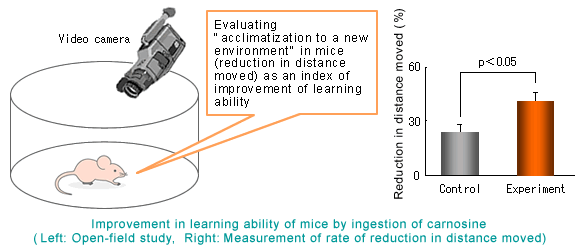|
|
 |
 |
 |
 |
Chicken Extract Containing Carnosine and Anserine |
 |
| |
|
|
| |
Features of Chicken extract |
|
| |
Chicken extract containing carnosine and anserine, which we can recommend with confidence, is a material whose functions have been proved by abundant evidence. It is expected to function in reducing fatigue in athletes and middle-aged or elderly people. |
|
| |
|
|
| |
What are carnosine and anserine? |
|
| |
 Carnosine and anserine are dipeptides that are contained in the skeletal muscles or brains of vertebrates in high concentrations. These substances may function to reduce muscle fatigue and improve learning ability because of an anti-oxidative effect and buffering capacity due to the presence of an imidazole group. Carnosine and anserine are dipeptides that are contained in the skeletal muscles or brains of vertebrates in high concentrations. These substances may function to reduce muscle fatigue and improve learning ability because of an anti-oxidative effect and buffering capacity due to the presence of an imidazole group. |
|
| |
Functional Data |
|
| |
1) Improvement of exercise performance 1) |
|
| |
Once daily eight adult males each received a beverage containing 500 mg carnosine and anserine. The subjects’ exercise performance was determined 30 min after they had ingested the test beverage. The total work in the treatment group was greater than in the control group. |
|
| |
|
|
| |
|
|
| |
|
|
| |
2) Improvement in learning ability 2) |
|
| |
Learning ability in mice receiving carnosine (0.8 mmol/kg body weight) was evaluated in an open-field experiment. Mice in the treatment group showed improved learning ability, increasingly reducing the distance they moved. |
|
| |
 |
|
| |
|
|
| |
3) Reduction in fatigue 3) |
|
| |
Once daily for a month 10 middle-aged or elderly subjects each received a tablet containing 200 mg of carnosine and anserine. At the end of the test, fatigue was evaluated by a questionnaire. Eye fatigue and whole-body fatigue in the treatment group were reduced more effectively than in the control group. |
|
| |
|
|
| |
 |
|
| |
|
|
| |
|
|
| |
References |
|
| |
1. Jun Ichikawa et al., 60th Annual Conference of the Japanese Society of Physical Fitness and Sports Medicine(2005)
2. S. Tomonaga et al., proceedings of 53rd ICoMST, 375-376 (2007)
3. Hirohiko Maemura et al., 58th Japan Society of Physical Education, Health and Sport Sciences (2007) |
|
| |
|
|
| |
|
|
| |
Unauthorized use or reproduction of these documents or the data on these pages is strictly prohibited unless under prior authorization. For more information on these materials, please contact our offices, listed below. |
|
| |
|
|
| |
Health Support Division, R&D Center, NH Foods Ltd.,
3-3 Midorigahara, Tsukuba, Ibaraki 300-2646, Japan
E-mail kinousei.sozai@nipponham.co.jp |
|
|
| |
|
|

